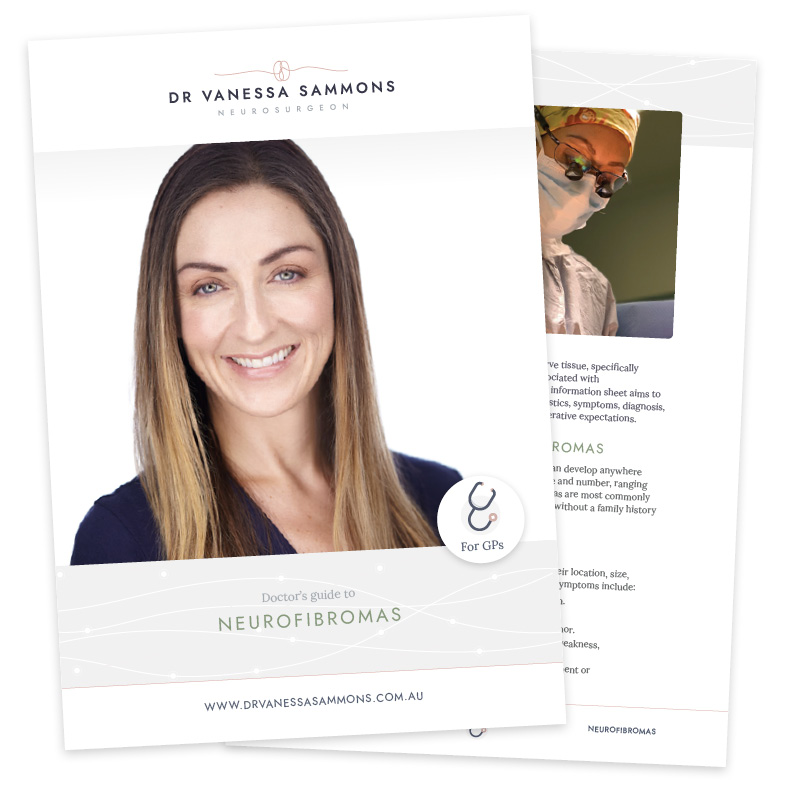What are Neurofibromas?
Neurofibromas are small, generally non-cancerous tumours. They grow from the nerve sheath, the lining of a nerve that protects it and facilitates fast electrical transmission. They may occur throughout the body and are especially problematic when they occur in the spine.
How Does a Neurofibroma Cause Nerve Compression?
Nerve Compression occurs when the neurofibroma grows and puts pressure (compression) on the parent nerve. It can also cause problems as the nerve fibres stretch around the growing tumour. Often neurofibromas go unnoticed for a time because there are few or mild symptoms signalling their presence.
What are the Symptoms of Neurofibromas?
When a neurofibroma grows large enough to disrupt a nerve in the body, it can alter sensory and motor function, sometimes severely. When it occurs on the spine, a neurofibroma can cause:
- Problems with balance and coordination
- Difficulty walking
- Numbness
- Tingling
- Pain in the extremities
- Incontinence
- Change or degradation of bone leading to the development of scoliosis
What Causes Neurofibromas?
Neurofibromatosis is a genetic disorder that can be inherited. It’s the result of a mutation in a gene responsible for the production of a protein that the body uses to regulate nerve tissue growth. Neurofibromatosis is characterised by multiple neurofibromas.
Often, people develop a single neurofibroma. The cause of this type of tumour is unknown.
When Should I Consult a Doctor?
Neurofibromas can remain painless and relatively invisible for years, presenting no real danger. When they become painful or cosmetically unappealing, it’s time to see a doctor. Other diseases may be responsible for any symptoms you are experiencing. Early diagnosis will facilitate early treatment, regardless of the cause.
How Is a Neurofibroma Diagnosed?
A preliminary consultation about neurofibromas begins with a discussion of your symptoms and medical history and a physical exam. The following imaging tests may be necessary for an accurate diagnosis:
- MRI – for a better picture of the problem
- EMG – to assess electrical pathways in the nerves
- Biopsy – to enable a pathologist to rule out other causes
These diagnostics are generally well-tolerated by patients. The results they yield are used to develop an effective, focused treatment.
What are the Treatments for Forearm Nerve Compression?
There are no medical treatments currently prescribed for neurofibromas. Researchers are exploring prospective therapies with drugs that block a specific protein associated with irregular cell growth. Sporadic neurofibromas can be managed without surgical intervention as they seldom cause discomfort.
Neurofibroma resection surgery is indicated when a neurofibroma:
- Causes pain
- Compresses a nerve
- Causes loss of neurological function
- Is causing problems due to its location
- Is unappealing from a cosmetic standpoint
What is Neurofibroma Surgery?
“The goal of surgery is to remove as much of the tumour as possible without causing further nerve damage,” reports the Mayo Clinic. The type of surgery will be determined based upon “the location and size of the tumour and whether it is intertwined with more than one nerve.” This will also determine whether your surgery is an in- or outpatient procedure. For example, neurofibroma surgery in the spinal area requires a hospital stay of 1 to 3 days.
You will be prepped prior to surgery and given general anaesthesia. A small incision at the site of the neurofibroma gives Dr Sammons the ability to see and access the tumour. Specialised instruments are used to separate the neurofibroma from the nerve sheath. When the procedure is complete, the incision is closed with self-dissolving sutures. Most surgeries are completed in less than an hour and patients return home the same day.
What Can I Expect After Surgery?
When surgery is complete, you will be taken to an observation room where you can be monitored during recovery. You can expect to feel drowsy when you awaken. This passes in a short time. There may be numbness at the surgical site, or you may feel uncomfortable. You will be given medication to manage your pain. Most patients return home the same day in the company of their chosen patient escort.
What Should I Do After Surgery?
To ensure a smooth recovery, you will be given a set of guidelines to follow. Among the things you should do:
- Monitor your progress. Contact Dr Sammons’ rooms immediately if you have an increase in pain or swelling.
- Keep your bandage in place as instructed (1 day to 1 week)
You can expect the symptoms related to neurofibromas to improve quickly after surgery, but full recovery may take as long as six months.
Should I Follow Up with Dr Sammons after Surgery?
A post-surgical follow-up is a must. You will be contacted by a practice nurse during the first week after surgery to set up your appointment, which is usually 10 days after surgery. If you have any concerns prior to that appointment, contact Dr Sammons for guidance.
Do Neurofibromas Come Back After Surgery?
Patients who undergo surgery for sporadic neurofibroma seldom see a return. Patients whose tumours are related to neurofibromatosis are likely to see additional tumours form, though not a specific regrowth of the excised tumour.
Please call our rooms if you have any additional concerns or questions.
